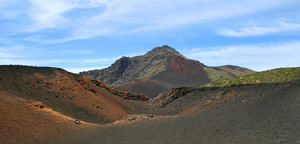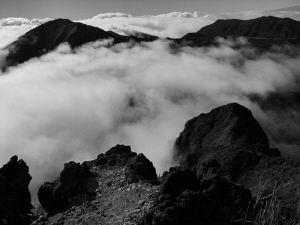 Mt. Haleakala is the largest mountain in the Pacific. It’s magnificent beauty and inspiring enormity has inspired both Hawaiians and tourists for centuries. Located on the island of Maui, Haleakala National Park is also one of the most diversely beautiful national parks in the United States. In a 2-hour drive to the summit of Mount Haleakala, a visitor passes through as many ecological zones as on a journey from Canada to Mexico. In fact, the original 17,000 acres of the park were protected in 1916, within one week of the inception of the national park system. The now 24,719 acre park is open year round, 7 days a week for the public to enjoy the varied terrain, which ranges from the tropical coastal region to the peak of Mount Haleakala at over ten thousand feet.
Mt. Haleakala is the largest mountain in the Pacific. It’s magnificent beauty and inspiring enormity has inspired both Hawaiians and tourists for centuries. Located on the island of Maui, Haleakala National Park is also one of the most diversely beautiful national parks in the United States. In a 2-hour drive to the summit of Mount Haleakala, a visitor passes through as many ecological zones as on a journey from Canada to Mexico. In fact, the original 17,000 acres of the park were protected in 1916, within one week of the inception of the national park system. The now 24,719 acre park is open year round, 7 days a week for the public to enjoy the varied terrain, which ranges from the tropical coastal region to the peak of Mount Haleakala at over ten thousand feet.
Mt. Haleakala unique ecological diversity and size have long inspired a sense of wonderment and curiosity. The name Haleakala actually means “house of the sun” in Hawaiian. According to legend, the grandmother of demigod Maui (for whom the island was named) helped her grandson capture the sun behind the mountain in order to slow its journey across the sky and lengthen the day. Today, the summit of the mountain is a spectacular place to watch the sunrise and/or sunset over the Pacific Ocean.
There are three main areas in Haleakala National Park:
Kipahulu The coastal region located about 10 miles from the city of Hana. The climate is wet, tropical, lush and warm year-round. Waterfalls and deep pools popular for swimming can be found here as well.
Wilderness This area was designated an official wilderness area in 1976 and the region contains a large variety of microclimates ranging from tropical to high altitude and arid. Some visitors do experience altitude sickness at these elevations (up to 10,000 feet) and temperatures usually range between 30-65 degrees.
 Summit The area at the top of Mountain Haleakala. Temperatures can easily drop below freezing at night at the summit and visitors are encouraged to bring warm clothing and be prepared for high altitude and colder weather.
Summit The area at the top of Mountain Haleakala. Temperatures can easily drop below freezing at night at the summit and visitors are encouraged to bring warm clothing and be prepared for high altitude and colder weather.
Haleakala National Park is expansive and offers a large variety of activity for tourists. Visitors can do anything from drive and enjoy the scenery to guided tours to camping to short day hikes. Here are some of the most popular activities in the park:
Where better to get a view of the stars than on the tallest mountain in the Pacific? The summit of Mt. Haleakala is renowned for its amazing sky watching. At 10,023 feet above the blue Pacific Ocean below, the volcano offers spectacular views of not only the island of Maui, and on fair weather days the view of two of the other Hawaiian islands, but also of the skies above. Removed from city lights and perched on top of the enormous mountain (which when measured from the sea floor is nearly 35,000 feet tall), Mt. Haleakala offers both astronomers and casual star watchers with stunning opportunities to look at the stars and planets above. On clear nights, the moons of Jupiter can be seen along star formations and countless other astronomic delights. Taking advantage of the unique vantage point, there is also scientific village located at the summit where scientists study astronomy and weather patterns. Visitors can rent binoculars at local shops before entering the park and many avid sky watchers bring telescopes. Sunrises and sunsets are also a popular time to enjoy the views from the top of Mt. Haleakala. Put your coffee in a thermos and bundle up to watch the sun rise over the Pacific and give light to the islands or pop open a bottle of wine and relax as the sun dips below the horizon.
The park has 3 wilderness cabins, which are reserved through a monthly lottery of those interested in staying in the cabins. The cabins sleep a maximum of 12 people and someone 18 or older must supervise all groups. They have pit toilets, but no potable water. All water must be filtered or boiled before consumption.
Holua Cabin This is the closest cabin at 6,940 feet in the shrub land near Koolau Gap, 3.7 miles down the Halemauu trail or 7.4 miles down the Keoneheehee trail.
Kapalaoa Cabin This cabin, located at 7,250 feet, offers a view of brightly colored cinder cones, subalpine plants and dramatic cliffs. It is located 5.5 miles down the Keoneheehee trail and 7.3 miles from the Halemauu trailhead.
Paliku Cabin This cabin at 6,380 feet is located at the east end of the wilderness valley at the base of a rain forest cliff. This cabin is a very strenuous 9.3-mile hike on Keoneheehee Trail and 10.1 miles on Halemauu Trail. This cabin is located in a particularly cool and lush area and clouds and fog can be seen rolling off of the high volcanic cliffs.
For more information on the wilderness cabins and how to reserve them, visit: http://www.nps.gov/hale/planyourvisit/wilderness-cabins.htm
Visitors to the park can also camp at two different primitive wilderness campsites, which are only accessible via a fairly strenuous hike. Permits are required, but are free. A 10 minute orientation is required and the spots are on a first come, first serve basis.
For more information on wilderness camping, visit: http://www.nps.gov/hale/planyourvisit/wilderness-camping.htm
If you’re not sure how much roughing it you want to do while visiting Haleakala National Park, but still want to camp, there are also two drive-up campgrounds. These campgrounds also operate on a first come, first serve basis and offer picnic tables, BBQ pits, drinking water and bathrooms.
Hosmer Grove campground is located on the way to the volcanic summit on the windy slopes of Mt. Haleakala. Be prepared for cold temperatures at Hosmer Grover as it is located near 9,000 feet in altitude and temperatures can drop to freezing at night.
Kipahulu Campground is located 1/8 of a mile from the Kipahulu visitor center and is near sea level overlooking the ocean cliffs. There is no potable drinking water here, so visitors must be prepared to filter or treat any water. Campers can also take the short hike to the Oheo Gulch from this campground, where there is a series of beautiful waterfalls and deep pools ideal for swimming.
There are many day hikes available to visitors to the park who may be interested in hiking and seeing some of the rare and native Hawaiian plant and animal species without spending the night in a tent. Hikes range from 10 minutes to a full day with varied levels of strenuousness. People interested in hiking in the park should visit one of the three visitor centers for trail information and maps.
Haleakala National Park is a spectacular and interesting destination, but the journey to the park is a sightseeing opportunity in itself. The famous Road to Hana is a several hour journey across historic one-lane bridges and past waterfalls and dramatic ocean cliffs.
Hours: The park is open 365 days a year, 24 hours a day (except for severe weather closures). The three visitor centers all have open hours, but each one is different:
Park Headquarters Visitor Center (7000 ft/2134 m) – daily, 08:00-16:00
Haleakala Visitor Center (9740 ft/2969 m) – daily, 06:30-15:30 (closed on December 25 and January 1)
Kipahulu Visitor Center (sea level) – daily, 09:00-17:00
Admission: Park visitors must buy a recreational use pass; there are several types of passes, but the most common are the General Car Pass which is $10 per vehicle and is valid for three days, or the Individual Entry (for those without a car) which is $5 and also valid for three days. If you’ll be visiting more than one National Park during your trip to Hawaii, consider buying a Tri-Parks Annual Pass, which is $25 and good for a year at Haleakala National Park, Hawaii Volcanoes National Park and Pu’uhonua o Honaunau National Historical Park. Any tours or transportation will cost extra above and beyong the entrance fees.
More Information: The National Park Service website for the park is here.